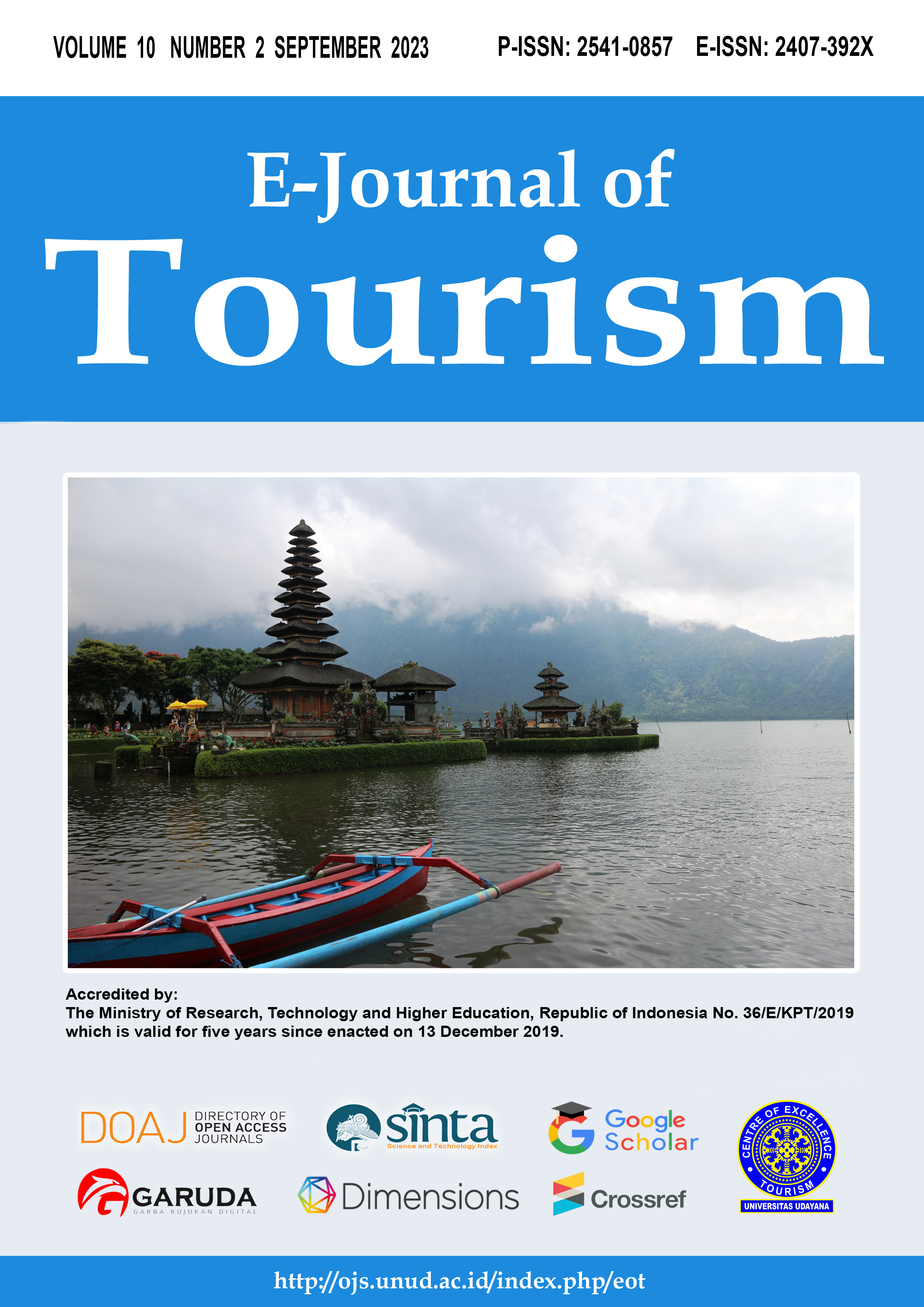The Waste Arising as An Effect of The Opening of River Tubing Tourism Place, Mayangsari City, Semarang
Abstract
Tourism objects besides providing benefits to managers and the surrounding community, also bring new problems, one of which is the waste problem. This article aims to analyze the waste problem at the new Mayangsari River tubing tourist attraction, Semarang City, and find out the forms of waste management at the Mayangsari River tubing tourist attraction, Semarang City. This study uses a descriptive qualitative research method. This research is located in Kalipancur Village, Ngaliyan District, Semarang City. The data in this study were collected through data collection techniques in the form of interviews, observation, and documentation. The informants in this study were taken from the management of the Tourism Awareness Group (Pokdarwis), the management of the Family Disaster Preparedness (KSB), the management of the River Care Community (KSP), the Rukun Warga and Rukun Tetangga groups, as well as the community, especially those who open businesses in these tourist areas. Data were analyzed using Miles and Huberman's interactive analysis model. The opening of the Mayangsari river tubing tour has resulted in an increase in the amount of waste generation. The increase in the amount of waste occurs on holidays in line with the high number of visitors. Every week about half of the contents of the garbage pickup is waste generated from tourist sites. The most common type of waste is plastic from food scraps. Trash is still found dumped around the river. Garbage is mixed even though organic and non-organic trash bins have been provided by the manager. Waste management through the application of 3 R (reduce, reuse, and recycle) has not been carried out by the management of this tourist spot. The waste generated from this tourist location is only limited to being collected then transported and then disposed of.
Downloads
References
Aziz, R., Yommi D., Hafizhul K., and Mikel F. 2020. Development of a Waste Management System in the Pariaman City Beach Tourism Area with the Reduce-Reuse-Recycle Approach. Serambi Engineering Journal , Vol. 5, No. 3, pp. 1188-1194.
Aziz, R., Yommi D., and Busrita EP 2020. Preliminary Study of Waste Management
in the Carocok Beach Tourism Area, Painan City. Journal of Science and Technology, Vol. 20, no. 1, pp. 77-85.
Dewi, RP (2017). Design of a Waste Management System to Support the Development of Creative Industries in Tourism Areas. Seminar Proceedings National Multi-Discipline Science.
Fajar and Hartati SR 2019. River Environment Conservation Efforts through Development Ecotourism River Tubing Mayangsari to Support Sustainable Development. ICESI Proceedings. Semarang: FIS UNNES.
Hardati, P., et al. 2016. Textbook of Conservation Education. Semarang: UNNES Press.
Harmayani, KD and IGM Konsukartha. 2007. Groundwater Pollution Due to Domestic Waste Disposal in Slum Environment Case Study of Banjar Ubung Sari, Ubung Village. Natah Settlement Journal, Vol. 5, No. 2. Pg: 92-108.
Kristina, NMR, et al. (2020). Management of Waste Generation to Maintain the Image of the Tourism Industry on Tourist Attractions in Bali. Tourism Scientific Journal. Vol. 25, no. 3, pp. 223-233.
Miles, Matthew B. And A Michael Huberman. 1992. Qualitative Data Analysis: A Sourcebook on New Methods. Tjetjep Rohendi Rohidi's translation. Jakarta: UIPress.
Moleong, Lexy J. 2004. Qualitative Research Methodology. Bandung: Rosdakarya Youth.
Government Regulation of the Republic of Indonesia Number 81 of 2012 concerning Management of Household Waste and Household-like Waste, in the State Gazette of the Republic of Indonesia of 2012 Number 188. Jakarta.
Government Regulation of the Republic of Indonesia Number 27 of 2020 concerning Specific Waste Management, in the State Gazette of the Republic of Indonesia of 2020 Number 141. Jakarta.
Regional Regulation of Central Java Province Number 3 of 2014 Concerning Waste Management in Central Java, Regional Gazette of Central Java Province of 2014 Number 3. Semarang.
Regional Regulation of the City of Semarang Number 6 of 2012 concerning Waste Management, in the Regional Gazette of the City of Semarang of 2012 Number 6. Semarang.
Regulation of the Minister of Public Works No. 3 of 2013, Implementation of Garbage Infrastructure and Facilities in Handling Household Waste and Household-like Waste. 2013.
Sahwan, FL (2004). Waste Management Strategy in the Thousand Islands Region. Journal of Environmental Engineering P3TL-BPPT. Vol. 5, No. 1, pp. 12-16.
Satmaidi, E. 2015. Deep Ecology Concepts in Environmental Law Arrangements.
Journal of Law Supremacy Law Research, Vol. 24, No. 2.
Spradley, James P. 1980. Participant Observation. USA: Holt, Rinehart, and Winston
Sugiyono. 2008. Qualitative Quantitative Research Methods and R&D. Bandung: Alphabet
Sutrisnawati, NK and Purwahita, AAARM (2018). The Phenomenon of Garbage and Bali Tourism. Scientific Journal of Hospitality Management. Vol. 9, No. 1, pp. 49-56.
Syaputra, M. 2019. Planning for Waste Management on the Hiking Trail of Mount Rinjani National Park. Journal of the Wilderness, Vol 2, No. 1, pp. 17-23.
Law of the Republic of Indonesia Number 18 of 2008 concerning Waste Management, in the State Gazette of the Republic of Indonesia of 2008 Number 69. Jakarta.
Vitasurya, VR (2014). Sawitri (Initial Tourism Waste): A Model of Waste Management for Tourism Activities in Importantsari Village, Yogyakarta. Journal of Compositional Architecture. Vol. 10, No. 5, pp. 315-326.

This work is licensed under a Creative Commons Attribution 4.0 International License.
The copyright of the received article shall be assigned to the journal as the publisher of the journal. The intended copyright includes the right to publish the article in various forms (including reprints). The journal maintains the publishing rights to the published articles.




















